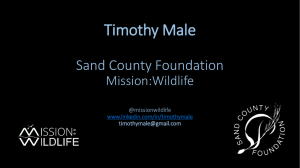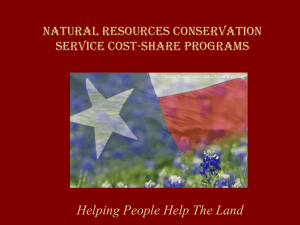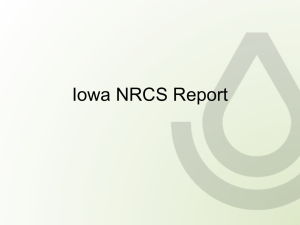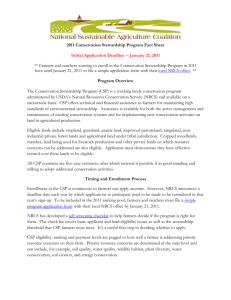Conservation Stewardship Program
advertisement
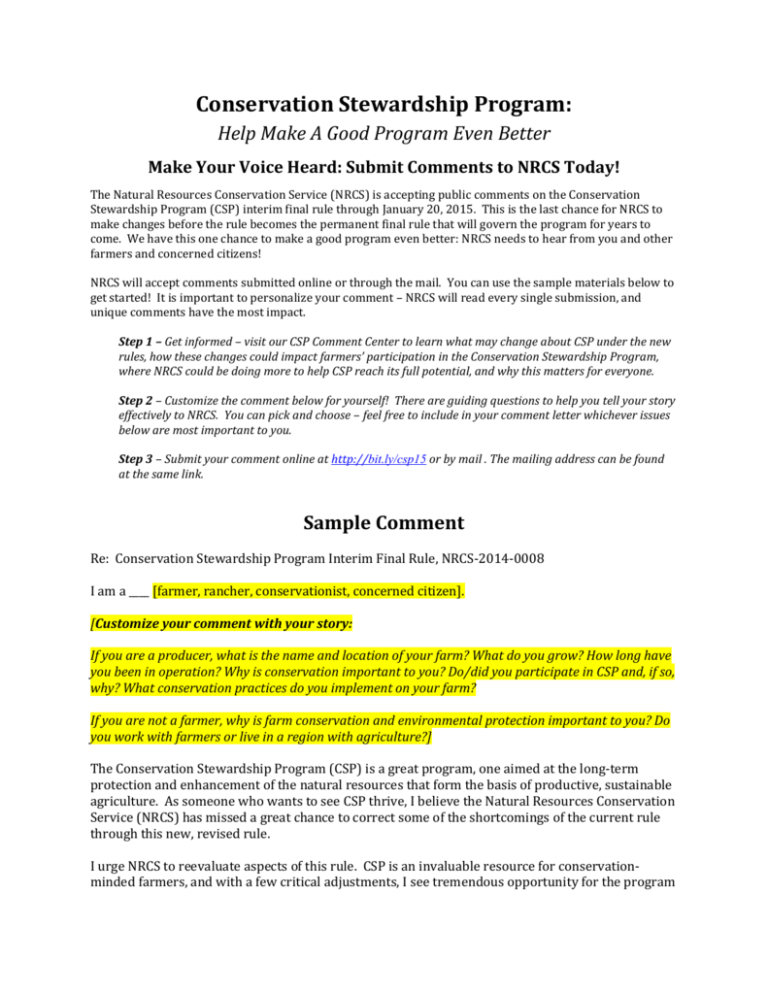
Conservation Stewardship Program: Help Make A Good Program Even Better Make Your Voice Heard: Submit Comments to NRCS Today! The Natural Resources Conservation Service (NRCS) is accepting public comments on the Conservation Stewardship Program (CSP) interim final rule through January 20, 2015. This is the last chance for NRCS to make changes before the rule becomes the permanent final rule that will govern the program for years to come. We have this one chance to make a good program even better: NRCS needs to hear from you and other farmers and concerned citizens! NRCS will accept comments submitted online or through the mail. You can use the sample materials below to get started! It is important to personalize your comment – NRCS will read every single submission, and unique comments have the most impact. Step 1 – Get informed – visit our CSP Comment Center to learn what may change about CSP under the new rules, how these changes could impact farmers’ participation in the Conservation Stewardship Program, where NRCS could be doing more to help CSP reach its full potential, and why this matters for everyone. Step 2 – Customize the comment below for yourself! There are guiding questions to help you tell your story effectively to NRCS. You can pick and choose – feel free to include in your comment letter whichever issues below are most important to you. Step 3 – Submit your comment online at http://bit.ly/csp15 or by mail . The mailing address can be found at the same link. Sample Comment Re: Conservation Stewardship Program Interim Final Rule, NRCS-2014-0008 I am a ____ [farmer, rancher, conservationist, concerned citizen]. [Customize your comment with your story: If you are a producer, what is the name and location of your farm? What do you grow? How long have you been in operation? Why is conservation important to you? Do/did you participate in CSP and, if so, why? What conservation practices do you implement on your farm? If you are not a farmer, why is farm conservation and environmental protection important to you? Do you work with farmers or live in a region with agriculture?] The Conservation Stewardship Program (CSP) is a great program, one aimed at the long-term protection and enhancement of the natural resources that form the basis of productive, sustainable agriculture. As someone who wants to see CSP thrive, I believe the Natural Resources Conservation Service (NRCS) has missed a great chance to correct some of the shortcomings of the current rule through this new, revised rule. I urge NRCS to reevaluate aspects of this rule. CSP is an invaluable resource for conservationminded farmers, and with a few critical adjustments, I see tremendous opportunity for the program to reach its goal of addressing natural resource and environmental challenges that face agriculture and the country as a whole. Specifically, I urge you to: 1. Base the ranking and payment rules for the program solely on environmental benefits and outcomes The purpose of CSP is to address the priority resource concerns of a particular state or watershed by encouraging producers to actively manage and improve their ongoing conservation activities and to add new conservation enhancements. Yet, NRCS consistently and very dramatically overemphasizes the importance of additional conservation activities while failing to adequately recognize and support ongoing conservation activities farmers are already undertaking. This is evident in the weighting of existing/ongoing versus newly adopted conservation measures, both in ranking applications and in determining per-acre payment rates. This misses the mark, making the program more of a traditional cost-share program rather than the forward-looking stewardship incentives program it was meant to be. At best, it forces the best stewards to accept lower payments than others, and at worst it keeps some of the best conservationists from accessing the program at all, while rewarding the late adopters of sound conservation systems. The program should reward environmental benefits and outcomes of both existing and new conservation activities equally, thereby recognizing the costs to the farmer and benefits to society of both ongoing and newly-adopted conservation measures. [Help NRCS understand why this matters: Do/did you participate in CSP, or try to participate? What conservation practices and activities did you already undertake before enrolling in the program? What level of work and effort and expense does it require to actively manage your existing conservation activities? If you applied but didn’t get in, do you know of other farmers that do less conservation than you do, but got in? If you are not a farmer, explain why you think it’s important to equalize treatment of ongoing and new conservation activities. In your participation in CSP, have you utilized the Conservation Measurement Tool? What improvements could be made to make it more accessible for farmers wanting to see the value of their ongoing or new conservation practices?] Recommendation to NRCS: NRCS should level the playing field so that CSP rewards environmental benefits and outcomes by equalizing the treatment of farmers who actively manage and improve ongoing conservation activities and farmers who adopt new conservation enhancements throughout both the CSP ranking and CSP payment structure. Differences in ranking and payments should reflect nothing other than actual or expected differences in environmental benefits, financial costs, and forgone income to the farmer. 2. Improve access for beginning & small-acreage farmers, including farmers growing fruits and vegetables and other high value crops Our agricultural system includes a wide range of farmers and farming operations. To truly encourage conservation across the agricultural landscape, CSP must be accessible to farmers of any experience level and farms of any scale. The next generation of American producers will need ample resources to establish themselves as good stewards of the land and effective conservationists. In supporting their investments in advanced conservation, the public also receives a big payoff in the form of many decades worth of environmental benefits. The program attempts to promote beginning farmer enrollment by setting aside 5 percent of CSP acres specifically for beginning farmers, and another 5 percent for socially disadvantaged farmers. NRCS has met and slightly exceeded the set-aside. This is a great start, but NRCS should “aim high” by setting its own higher enrollment goal for beginning farmers. Given that beginning farmers currently make up over 17 percent of farms and 25 percent of farmers (according to the Census of Agriculture), it seems both reasonable and fair for NRCS to set a goal to have that same percentage of CSP acres going to beginning farmer contracts. CSP must not only be more accessible to beginning farmers, but also to small acreage farming operations. Almost 65 percent of U.S. farms are between 1 and 179 acres in size, with one-third of U.S. farms ranging between 1 and 49 acres, according to the 2012 Census of Agriculture. Small acreage farms account for a significant portion of agricultural land and, as such, have tremendous potential to address resource concerns through CSP. In addition, small-scale farmers tend to crop their land more intensively. Although this may increase the risk for resource concerns like groundwater contamination or soil erosion, it also makes high-level conservation practices—including intensive cover cropping and high level IPM—more feasible, and more necessary. Currently, the CSP minimum annual contract payment sits at $1,000 for historically underserved producers, with no minimum for other producers. Given the time it takes a farmer to go through the application and contracting process, contract payments below $1,000 offer little incentive to participate in the program. More needs to be done to increase the programs attractiveness and accessibility to smaller-acreage producers and truly incorporate agricultural operations across all scales. CSP payments are determined by multiplying payment rates by the number of acres. Therefore, in most cases, small acreage farms lack the acreage for CSP to pay off, even if they’re doing more intensive and advanced conservation on those acres than much larger farms enrolled in CSP. By increasing the minimum contract payment and making all successful applicants eligible for the minimum payment, NRCS will ensure small acreage farmers can cost-effectively implement conservation practices through CSP. [Help NRCS understand why this matters: Are you a beginning farmer or do you know beginning farmers? Tell your story (or their story) about getting started in farming and conservation. What challenges did you face or are you facing currently? Did or could CSP help you address those challenges? If you farm on small acreage, would you be inclined to implement more conservation practices if they were more cost-effective? Have you considered CSP but decided against it because it didn’t seem worth it? Do you grow specialty crops, or high-value organic crops? If so, does CSP work for you, and how could it be improved to better address your needs?] Recommendation to NRCS: NRCS should make CSP more accessible to beginning farmers and small-acreage farmers. Specifically, NRCS should: a. Set a goal of at least 15 percent of all CSP acres to be enrolled by beginning farmers. b. Raise the minimum payment level from $1,000 to $1,500 to ensure the program is cost-effective for smaller-acreage farming operations, and extend that new, $1,500 minimum payment level to all successful applicants to ensure that all farmers can benefit from the program. 3. Ensure fiscal responsibility Farmers routinely have to find the best ways to work efficiently and get the most bang for the buck — and we expect NRCS to do the same when it comes to conservation. Financial resources must be used wisely so as many farmers who are interested in CSP as possible have an opportunity to participate in the program. Allowing some farmers to accumulate excessively large payments through CSP drains the program’s resources and ultimately limits participation for other good stewards of the land. By statute, CSP contracts are limited to $40,000 per fiscal year and $200,000 from fiscal year 2014 through 2018. But the rule continues to allow for the doubling of the statutory limit for joint operations. Worse, the rule fails to require that beneficiaries be active farmers, and allows farms to have multiple contracts despite the statutory stipulation that the entire farm must be enrolled in the CSP contract. Combined, these loopholes allow some farms to rack up very large contracts, far in excess of the statutory limit. In order to ensure that CSP has sufficient funding to support as many qualified prospective conservationists as possible, these payment limit loopholes must be closed. Closing the payment limit loophole is one way to improve the fiscal soundness of CSP; another is to raise the standard of stewardship. In order to be eligible for a CSP contract, applicants must meet or exceed a stewardship threshold for at least two priority resource concerns. Having such a standard in place is incredibly valuable, but the current definition of stewardship threshold is vague. The preamble to the rule outlines more specific language, stating that “NRCS guides its efforts to set stewardship thresholds at sustainable levels for natural resource treatment,” but such language is not found in the rule itself. By using this preamble language to clarify the stewardship threshold definition, NRCS will be taking a step to ensure that CSP has high standards to encourage more conservation and recognize the best stewards of the land. [Help NRCS understand why this matters: Do you have a CSP contract? Will holding all CSP farms to the $200,000 payment limit affect you? Are you concerned that the reduction in available acres from 12.8 to 10 million nationally means it will be harder to get a contract? Does you think the reduction in acreage makes it even more important to ensure that conservation dollars go to family farmers, not passive investors or absentee general partners? Does USDA’s general practice of creating loopholes to get around the intent of Congress in establishing payment limits offend your sense of fairness and fiscal responsibility? Why is it important to you that CSP have high standards for stewardship?] Recommendation to NRCS: NRCS needs to run CSP in an efficient and fiscally responsible manner. Specifically NRCS should: a. b. Close the loopholes that allow the largest farms to exceed the payment limits established by Congress. Include a requirement that beneficiaries be actively engaged in the farming operation. This will conserve financial resources to allow more farmers to participate in CSP. Clarify and enhance the definition of stewardship threshold by using language from the preamble in the rule itself, ensuring that the stewardship thresholds used in CSP will be set at the sustainable use levels (also sometimes referred to as the nondegradation level or the resource management system level), thereby ensuring that CSP has high standards to encourage more conservation and recognize the best stewards of the land.

